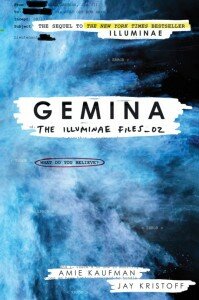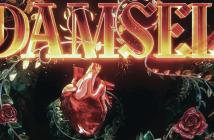 Illuminae swept through the YA world last year, racking up award nominations, sweeping up the bestsellers list, and landing authors Amie Kaufman and Jay Kristoff on the dreaded “might kill that character you really love” list. The innovative novel, told through found documents, followed exes Kady and Ezra, who find themselves working together when their planet gets invaded. They’re forced onto two separate spaceships, whose crews are hiding secrets from those on board – secrets they’re determined to uncover.
Illuminae swept through the YA world last year, racking up award nominations, sweeping up the bestsellers list, and landing authors Amie Kaufman and Jay Kristoff on the dreaded “might kill that character you really love” list. The innovative novel, told through found documents, followed exes Kady and Ezra, who find themselves working together when their planet gets invaded. They’re forced onto two separate spaceships, whose crews are hiding secrets from those on board – secrets they’re determined to uncover.
Next month, the sequel hits shelves. Gemina follows Hanna, the station captain’s pampered daughter, and Nik, the reluctant member of a notorious crime family. But while the pair are struggling with the realities of life aboard the galaxy’s most boring space station, little do they know that Kady Grant and the Hypatia are headed right toward Heimdall. When an elite BeiTech strike team invades the station, Hanna and Nik are thrown together to defend their home. But alien predators are picking off the station residents one by one.
Gemina releases on October 18 from Knopf Books for Young Readers.
Kaufman and Kristoff jointly answered questions via email; answers come from both of them unless specified otherwise. For more on Kaufman, visit her website or follow her on Twitter. For more on Kristoff, visit his website or follow him on Twitter.
Let’s talk about Gemina! Who will we meet in this story – and will old friends make a reappearance?
Gemina is a sequel and a companion novel to Illuminae, so you’re meeting a new cast of characters as well as following the characters who survived book 1.
Chronologically, Gemina picks up around 5 minutes after the end of Illuminae. But the initial focus of the book is on Jump Station: Heimdall, a space station orbiting a seven-way wormhole that leads to the wartorn Kerenza system, as well as back to the galactic Core. The refugee crew of the Hypatia were trying to reach the sanctuary of Heimdall for most of Illuminae, and in Gemina, we finally discover why their distress calls went unanswered.
Initially, Gemina focuses on Hanna Donnelly, the pampered daughter of the station’s commander, and Nik Malikov, a reluctant member of the station’s criminal underbelly, as they try to fight off a BeiTech invasion force sent to intercept and destroy the incoming Hypatia before news of the atrocities in book 1 get out to the universe at large. But eventually, the Hypatia plotlines and Heimdall plotlines intersect, and all hell breaks loose.
How much research for Gemina did you have to do in regards to the scientific aspects? Were you able to pull things you hadn’t been able to use in Illuminae?
Yes indeed. Gemina is more of a science fiction novel in that sense – we can’t talk too much about it for fear of spoiling things, but Heimdall station is built around a seven-way rip in the skin of the universe. So when things begin to go wrong on the station, they go wrong all the way.
As for research, we followed the same channels as we did in Illuminae – listened to and read a lot of content from astronauts and physicists, then wrote the book and ran it all past our own astrophysicist buddy who vetted everything in Illuminae. A lot of what people think they know about space comes from Hollywood, and Hollywood often sacrifices facts for the sake of spectacle. But we’re pleased to report we didn’t have quite so many notes from our astrophysicist this time through – so we’re slowly learning to separate the fact from the fiction.
You’re both known for killing off characters, though in Illuminae, the main death gets a bit of a twist. How many deaths will we see in Gemina?
We’re firm believers in the idea that victory without sacrifice is meaningless. We want you to be afraid that not all the characters you love are going to make it through this thing alive, and spoilers, they won’t. But to us, that’s what storytelling is about, and the losses you suffer along the way make victory all the sweeter.
As for death tallies in Gemina, we won’t give exact figures. You may be assured they are frequent and plentiful.
Both of you are used to writing series and have penned them in the past. Between Illuminae and Gemina, what became different in how you drafted the book? Were there things you learned from working on Illuminae that made writing Gemina easier?
The design process was certainly easier this time through. We’ve created a sort of routine in the way we instruct the (amazing) design department at Random House, and there are some templates from Illuminae that can be reformatted for Gemina. But of course, we included a few new document formats this time through because we like to pitch curve balls.
In terms of the actual writing, we really stuck to a similar routine as Illuminae because it worked so well the first time. We can’t properly express just how much fun these books are to create—it’s an incredible amount of effort, but you can’t actually call it hard work. It’s more like hard fun.
If you could co-write a short story set in the Illuminae world with anybody besides who you’re already writing with, who would you drag into the mayhem with you?
Douglas Adams. But he’s dead, so unless you’ve a necromancer on your staff, we’re SooL.
What would be your #1 tip for aspiring writers who are trying to tackle huge sci-fi worlds?
Start with the characters. They’re the core of any story, scifi or otherwise. Working in SF and fantasy, it’s easy to get caught up in the creation of the setting, but the heart and soul of your story needs to be the people that inhabit that setting.
Readers fall in love with characters, not worlds.
Knowing an astrophysicist doesn’t hurt either.
What else do you want people to know about Gemina?
We wanted the book to be bigger than Illuminae, and not just in terms of page count. So to that end, we created a bunch of new document types for the story.
The coolest addition is a visual diary—our MC Hanna is an illustrator who records her thoughts by drawing them, and during the siege of Heimdall, she has her trusty journal with her. We’re incredibly pleased to report that Marie Lu, the #1 New York Times bestselling author of the Legend and Young Elites series is going to be doing all of Hanna’s illustrations. We’ve seen the finished product and they look INCREDIBLE.
What would you recommend to readers to tide them over until they can sink their teeth into Gemina?
Kristoff: I just finished Three Dark Crowns by Kendare Blake and it pressed every single one of my fantasy buttons. Loved it. I’m also reading And I Darken by Kiersten White and it’s wonderful – dark, political, complex. I can’t recommend it enough.
Kaufman: I got an early read of Marie Lu’s The Midnight Star, and I thought it was the perfect ending to the series. Blew me away. And if I can reach back a few months, I’d pick out Julie Eshbaugh’s Ivory and Bone, which plays with storytelling in lots of interesting ways—it’s a gender-flipped, prehistoric Pride and Prejudice. Loved it.



2 Comments
Aaaahhhhh I can’t wait for Gemina! I pre-ordered my copy back in June 😀
Pingback: 8 YA books to watch out for in October 2016 - YA Interrobang